Foraging Guides
Are Foraging Societies Egalitarian? Discover the Details!
Keen to uncover the secrets of egalitarian societies, delve into the world of foraging communities where cooperation and mutual respect reign supreme.
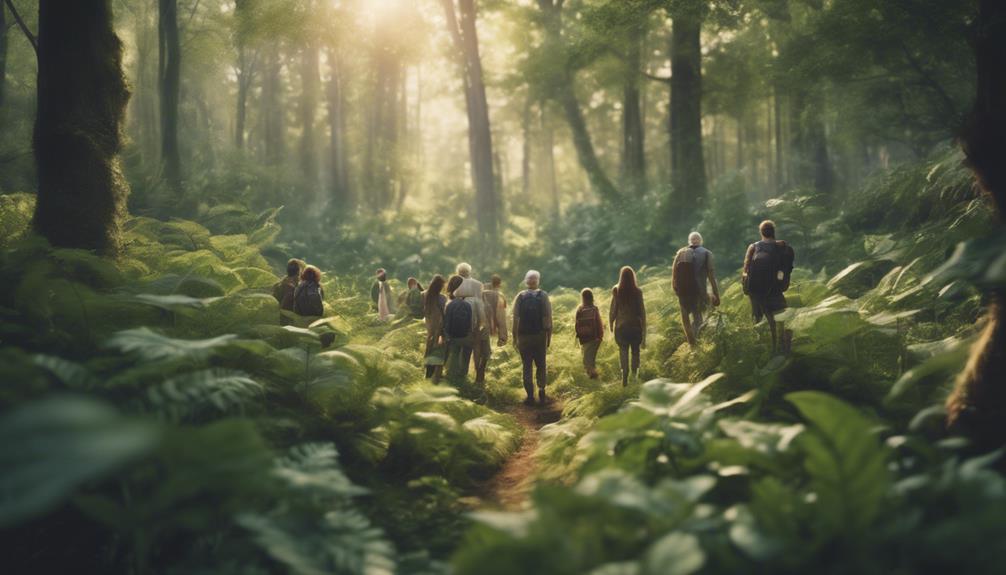
You'll often find that foraging societies, such as those of the Ju/hoansi San, Hadza, and !Kung, are structured around egalitarian principles, which guarantee equal access to resources and opportunities, fostering a sense of community and cooperation. These societies rarely exhibit social stratification, ensuring equal decision-making and resource access. Leaders are informal and based on age, experience, or knowledge, with collective decision-making among members. Cooperation and mutual respect for survival are essential, with shared resources and reciprocity being fundamental principles. As you explore further, you'll uncover more about how these societies maintain social harmony and cooperation.
Key Takeaways
- Foraging societies operate on egalitarian principles, ensuring equal access to resources and opportunities for all members.
- These societies lack strong ruling classes and social stratification, promoting collective decision-making and cooperation.
- Informal leaders emerge based on age, experience, or knowledge, with a fluid leadership structure that adapts to changing needs.
- Resource sharing and cooperation are fundamental principles, with an emphasis on equal access to resources and mutual support.
- Decision-making processes prioritize the collective good, involving all members and promoting social harmony and cooperation.
Defining Egalitarianism in Foraging Societies
In foraging societies, egalitarianism is a fundamental principle that guarantees you, as a member, have equal access to resources and opportunities, which in turn fosters a sense of community and cooperation. This means that you'll rarely find social stratification, where some members are considered superior to others. Instead, everyone has an equal say in decision-making and equal access to food, shelter, and other essential resources.
This egalitarian principle is vital in foraging societies, as it promotes collective well-being and discourages hierarchical structures. By sharing resources and working together, members can focus on survival and thrive in their environment. You'll often find that both men and women contribute equally to the community's survival, with no single individual or group dominating others. This lack of social stratification ensures that everyone has an equal opportunity to thrive, and cooperation becomes the cornerstone of community life.
Structure of Hunter-Gatherer Communities

As you explore the structure of hunter-gatherer communities, you'll find that while leadership hierarchies exist, egalitarianism is still practiced in daily life.
You'll notice that resource sharing is a fundamental norm, ensuring everyone has access to the same resources.
Leadership Hierarchy Exists
You'll often find that hunter-gatherer communities, despite their egalitarian nature, have informal leaders who emerge based on age, experience, or knowledge. These leaders don't hold permanent positions, but rather, they're recognized for their expertise in specific areas. For instance, an elderly member might be sought out for guidance on spiritual matters, while a skilled hunter might take the lead on a hunting expedition. This fluid leadership structure allows for a flexible and adaptive social hierarchy, where individuals can take on different roles depending on the situation.
While social hierarchies do exist in foraging societies, they're not based on power dynamics or status. Instead, they're centered around maintaining social harmony and cooperation. Decision-making involves consensus-building, where everyone has a say in the matter. This collective approach ensures that no single individual holds too much power, and that everyone's voice is heard. In this sense, leadership in foraging societies is more about facilitating collaboration than exercising authority.
Egalitarianism in Practice
As you explore the structure of hunter-gatherer communities, it becomes clear that egalitarianism is woven into the fabric of daily life, where equal access to resources and shared efforts for survival are the norm. In these societies, everyone contributes to the community's well-being, regardless of gender.
You'll notice that division of labor exists, but resources are shared among members to maintain social harmony. This emphasis on cooperation and fairness prevents the formation of hierarchical structures, making sure that no single individual or group dominates others.
As you investigate further, you'll find that hunter-gatherer societies value the contributions of all members, promoting a sense of equality. The absence of strong ruling classes fosters a sense of equality and collective decision-making among members.
This collective approach ensures that everyone has a say in the community's affairs, further reinforcing egalitarian principles. In these societies, cooperation and mutual respect are essential for survival, making egalitarianism a fundamental aspect of daily life.
Resource Sharing Norms
In foraging societies, shared resources are the norm, with gathered food and materials distributed equitably among all members to guarantee everyone's survival and well-being. Cooperation and reciprocity are fundamental principles in these communities, where gathered resources are shared among all individuals.
This egalitarian approach promotes social harmony by preventing the development of hierarchical structures, ensuring everyone has access to the resources they need.
In these societies, division of labor doesn't lead to unequal resource distribution, as all members benefit from shared efforts. The emphasis on equal resource access highlights the value placed on the contributions of all members, regardless of gender.
This means that everyone, regardless of their role, has an equal stake in the community's resources.
Resource Sharing and Cooperation

As you explore the world of foraging societies, you'll notice that resource sharing and cooperation are essential components of their survival strategy.
You'll see that shared food resources and cooperative hunting practices are key to their egalitarian way of life, ensuring everyone has access to the necessities.
Shared Food Resources
You're part of a foraging society where sharing food resources is a fundamental aspect of community life. As a hunter-gatherer, you're well aware that cooperation is key to survival. You work together with your community to gather resources, and then distribute them among all members. This egalitarian principle guarantees everyone has equal access to food, preventing individual hoarding and promoting group survival.
In your society, shared food resources are more than just a necessity – they bring people together. When you share meals, you strengthen social bonds and foster a sense of community. This collective approach also helps to avert scarcity and ensures that everyone has enough to eat. By working together, you've developed a system that promotes fairness and cooperation, which is essential for the well-being of your community.
As you go about your daily activities, you're reminded that shared food resources are a cornerstone of your society. You see it in the way people come together to hunt and gather, and in the way meals are shared among families and friends. It's a simple yet powerful principle that has been passed down through generations, and it continues to bring your community closer together.
Cooperative Hunting Practices
As you explore the world of foraging societies, you'll discover that cooperative hunting practices play a crucial role in their survival. Frequently, cooperative hunting practices in foraging societies rely on collective efforts to access a variety of food sources, mitigating individual risk and fostering reciprocity among community members.
In these societies, cooperative hunting involves resource sharing and collective cooperation, which promotes social cohesion and egalitarian principles. This collective approach also allows foragers to access a variety of food sources, reducing individual risk and ensuring that all members benefit from the group's success.
Some key aspects of cooperative hunting practices include:
- Shared responsibilities: Hunting tasks are often divided among community members, regardless of gender roles, to guarantee everyone contributes to the collective effort.
- Reciprocal benefits: The sharing of hunted resources fosters reciprocity and strengthens social bonds within the community.
- Equal distribution: Resources are shared equally, promoting social cohesion and reinforcing the egalitarian nature of foraging societies.
Gender Equality in Foraging Societies

In most food-foraging societies, men and women share responsibilities, with a division of labor emerging mainly in hunting-focused groups. This egalitarian approach to gender roles is a hallmark of foraging societies. You'll notice that women in these societies may face limitations in gathering food due to pregnancy and lactation, but this doesn't lead to gender stratification.
| Society | Gender Roles | Egalitarian Principles |
|---|---|---|
| Ju/hoansi San | Overlapping roles, shared hunting and gathering | Flexible roles, no strict division |
| Hadza | Women gather, men hunt | Shared decision-making, no dominance |
| !Kung | Shared hunting, gathering, and childcare | No gender-based hierarchy |
| Inuit | Women gather, men hunt, shared childcare | Egalitarian decision-making |
| Yanomami | Women gather, men hunt, shared childcare | Flexible roles, no gender stratification |
As you can see, foraging societies exhibit egalitarian principles with flexible gender roles that can be exchanged based on circumstances. This lack of strong domestic-public dichotomy leads to weak gender stratification, allowing for a more equal distribution of responsibilities and power.
Debunking the Myth of Primitive War
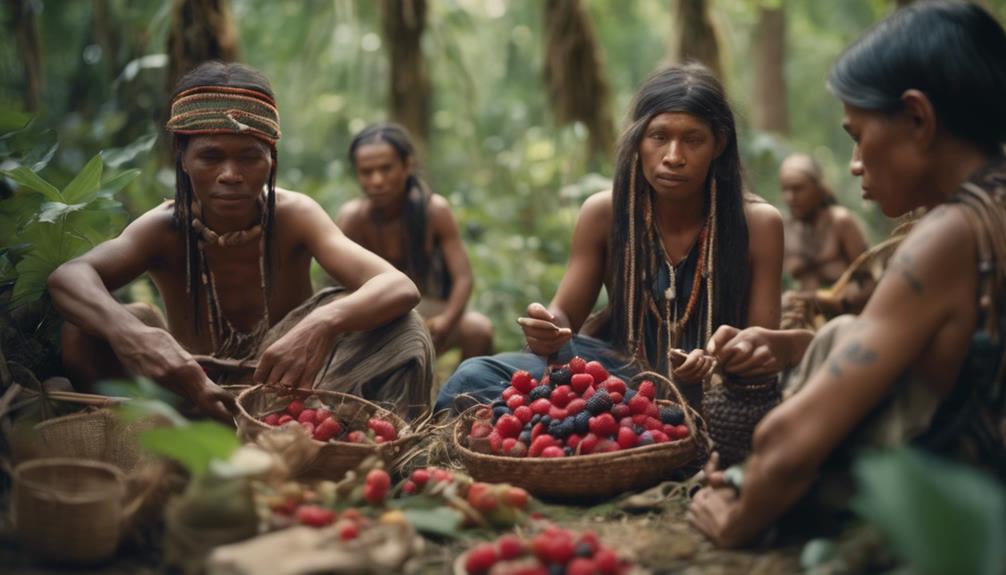
Challenging the widespread notion that foraging societies were inherently warlike, recent ethnographic and archaeological findings have uncovered a more complex and cooperative reality. You may have thought that hunter-gatherer communities were constantly at war, but the truth is that conflict wasn't as prevalent as previously believed.
In fact, studies show that foraging societies tend to prioritize maintaining group harmony, and conflict resolution strategies often take center stage.
Here are some key takeaways:
- Foraging societies typically exhibit low levels of intergroup violence and warfare.
- Archaeological and anthropological findings emphasize cooperation and conflict resolution over warlike tendencies.
- Egalitarian social structures in foraging societies discourage large-scale organized warfare.
These findings debunk the myth of primitive war in foraging societies, revealing a more nuanced and peaceful reality.
As you explore the world of hunter-gatherer communities, remember that cooperation and harmony were often the guiding principles, not war and conflict.
The Role of Reciprocity and Sharing
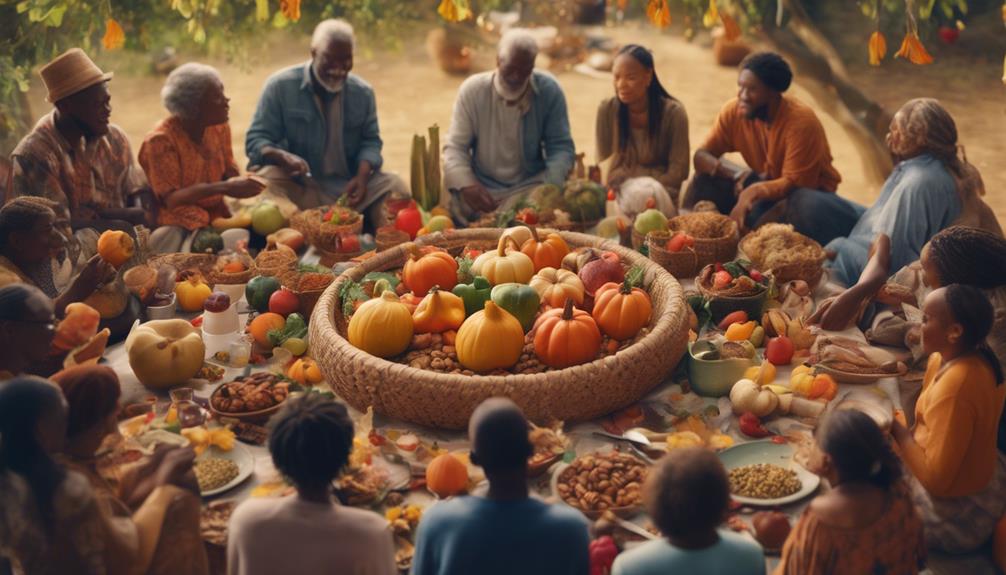
You'll often find that reciprocity and sharing are the glue that holds foraging societies together, fostering a sense of community and cooperation that's essential to their survival. In these societies, individuals rely on reciprocity to exchange goods and services without the need for formal trade. This reciprocal exchange contributes to building trust and maintaining cooperative relationships within the group.
| Principle | Impact on Society |
|---|---|
| Reciprocity | Fosters trust and cooperation |
| Sharing | Strengthens community bonds |
| Mutual Support | Guarantees equality among members |
| Cooperative Relationships | Promotes social cohesion |
| Resource Distribution | Guarantees equitable distribution of resources |
Foraging Societies' Decision-Making Processes
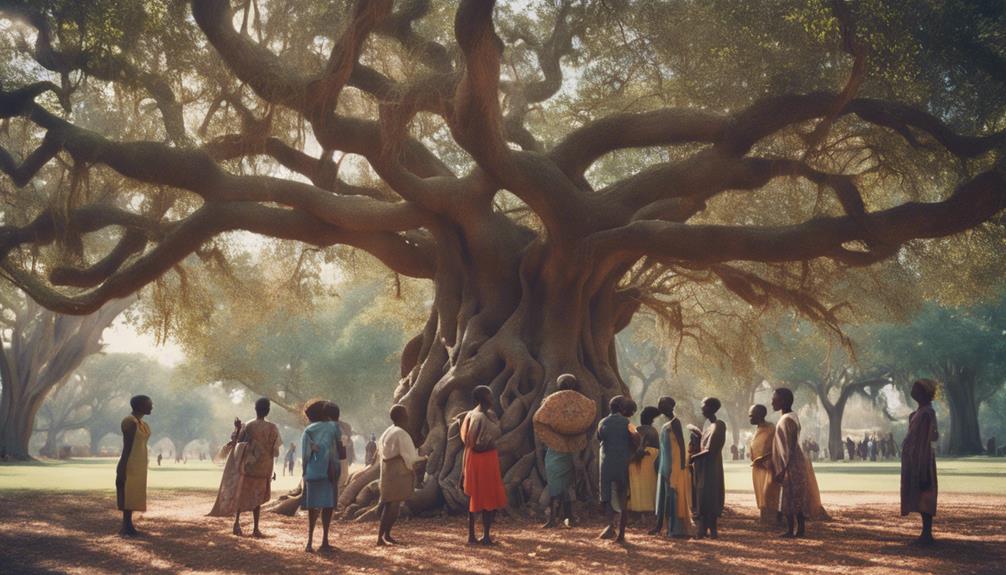
When it comes to making decisions, foraging societies rely on consensus-based processes, where every member has a voice and a stake in the outcome. You'll often find that decision-making in these food-foraging societies is participatory, involving discussions among group members to reach agreements. This collective approach guarantees that decisions are based on the well-being of the entire group, rather than individual interests.
Here are some key aspects of decision-making in foraging societies:
- Leadership is temporary and task-based: Leadership roles are often rotated based on the task at hand, promoting equality in decision-making.
- Conflict resolution is through dialogue and mediation: Conflicts are resolved through open dialogue and mediation, maintaining harmony within the group.
- Decisions prioritize collective needs: Decisions are made with the collective needs of the group in mind, ensuring everyone's well-being is considered.
In foraging societies, decision-making is a collaborative effort that prioritizes the well-being of the entire group. By involving all members in the decision-making process, these societies foster a sense of equality and cooperation.
Maintaining Social Harmony and Cooperation

As you explore the intricacies of foraging societies, it becomes clear that maintaining social harmony and cooperation is vital to their survival, as it guarantees equal access to resources and fosters a sense of shared responsibility. In these societies, cooperation is key to ensuring everyone has a fair share of resources, and decision-making processes prioritize the greater good.
| Aspect | Description | Impact |
|---|---|---|
| Division of Labor | Tasks are divided among members | Efficient use of skills and resources |
| Shared Resources | Resources are shared equally among members | Ensures equal access to necessities |
| Collaborative Efforts | Members work together for survival | Fosters a sense of shared responsibility |
Frequently Asked Questions
Are Foraging Societies Egalitarian?
You wonder if foraging societies are truly egalitarian, and the answer is yes, they are, as they promote equal access to resources, flexible gender roles, and collective learning, fostering social harmony and cooperation among members.
What Does Food Foragers Are Said to Be Egalitarian Mean?
You find that food foragers are said to be egalitarian because they prioritize equal access to resources, share food, and have flexible gender roles, ensuring everyone contributes and benefits equally, with no one person dominating others.
Were Hunter-Gatherer Societies Not Egalitarian?
As you dig into the past, you'll find that hunter-gatherer societies weren't entirely egalitarian, with prehistoric burials like Sungir's richly adorned graves hinting at social hierarchies, challenging the idea of complete equality.
What Were the Characteristics of Most Foraging Societies?
You'll find that most foraging societies are characterized by egalitarian principles, flexible gender roles, and a lack of domestic-public dichotomy, leading to weak gender stratification and a strong sense of cooperation and social harmony.
Conclusion
As you've learned, egalitarianism in foraging societies is more than just a myth. These communities thrive on cooperation, resource sharing, and reciprocity.
Decision-making is a collective effort, and social harmony is maintained through a delicate balance of power.
So, the next time you're stuck in a traffic jam, remember that ancient foragers had it right – sharing is caring, and equality is key to a harmonious society.
Who knew that going back to the Stone Age could be the key to a utopian future?
Foraging Guides
Does Mining Speed Affect Foraging? Discover the Connection!
Optimize your resource collection by uncovering the surprising truth about Mining Speed and Foraging, and how to maximize your gathering efficiency.
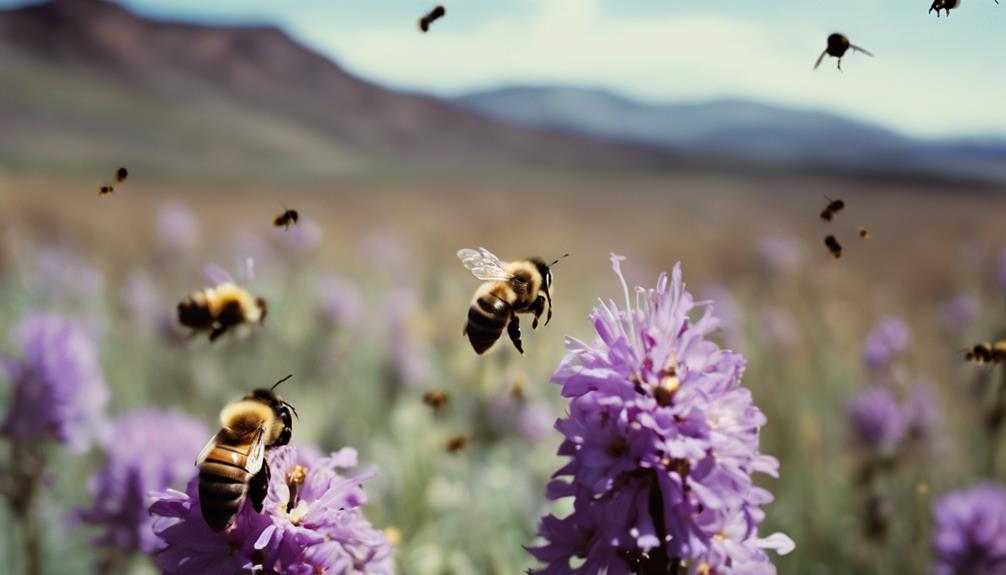
You're likely wondering how Mining Speed affects Foraging, and the answer is that it doesn't, at least not directly, as Mining Speed solely focuses on breaking blocks efficiently. Mining Speed boosts your block-breaking abilities, reducing base breaking time, but it doesn't impact your foraging efficiency. Foraging skills and tools determine how quickly you gather resources. To optimize your resource gathering, separate Mining Speed from Foraging and focus on improving your Foraging skill level and using the right tools. Want to maximize your resource collection? Stay tuned to learn how to optimize your Mining Speed and Foraging strategies.
Key Takeaways
- Mining Speed enhances block breaking efficiency, but does not directly impact foraging abilities or resource gathering speed.
- Foraging efficiency relies on separate skills, tools, and strategies, unrelated to Mining Speed boosts.
- Improving Mining Speed reduces block breaking time, allowing more focus on other aspects, including foraging, but is not a direct correlation.
- Boosting Mining Speed can indirectly enhance foraging efficiency by allowing more time for foraging, but does not influence foraging abilities.
- Optimizing Mining Speed and Foraging requires separate strategies, with a focus on improving Foraging skill level and using appropriate tools.
Understanding Mining Speed Basics
When you start exploring the world of SkyBlock, it's important to understand that Mining Speed plays a vital role in determining how quickly you can break blocks, including those valuable foraging blocks. This fundamental concept is essential for optimizing your gameplay experience.
As you explore further, you'll find that increasing your Mining Speed can greatly reduce the base breaking time for blocks. One effective way to achieve this is by utilizing the Drill Mechanic!, which can boost your Mining Speed.
Additionally, equipping yourself with Mining Gear that has Mining Speed status or applying the Efficiency Enchantment can also enhance your Mining Speed. What's more, there's no known cap on Mining Speed, so you can continually improve your speed through various methods.
How Mining Speed Affects Blocks

As you focus on optimizing your Mining Speed, you'll notice a significant impact on how quickly you can break blocks, including those valuable foraging blocks that are essential to your SkyBlock progress. With a Mining Speed boost, you'll be able to break blocks faster, giving you more time to focus on other aspects of your SkyBlock adventure. This is especially vital on islands where foraging is a key activity, as every second counts in maximizing your resource gathering.
As you increase your Mining Speed, you'll notice a substantial decrease in the time it takes to break blocks. This means you'll be able to collect resources faster, giving you a significant advantage in your SkyBlock journey. With the right tools and upgrades, you can maximize your Mining Speed, resulting in faster and more efficient foraging.
The Impact on Resource Gathering

You'll soon discover that your Mining Speed boost has little to no impact on your resource gathering, especially when it comes to foraged materials like logs, wheat, or carrots. This is because Mining Speed is specific to breaking blocks and mining ores, whereas Foraging is a separate skill focused on gathering resources like wood, crops, and other natural materials.
Increasing your Mining Speed per second won't magically speed up your foraging process. Instead, your Foraging efficiency is influenced by different factors such as the level of your Foraging skill, the tools you use, and specific perks. While Mining Speed is important for mining ores, Foraging requires its own strategies and optimizations to maximize resource gathering.
Mining Speed and Foraging Correlation

As you explore the connection between Mining Speed and Foraging, you'll discover that it's not as straightforward as you might think.
While increasing your Mining Speed won't directly impact your Foraging efficiency, there are underlying factors at play that can affect your resource gathering experience.
Let's examine the points that matter, including resource availability, Mining Speed's hidden impact, and Foraging efficiency boosts, to get a clearer picture of what's really going on.
Resource Availability Matters
When managing your SkyBlock resources, recognizing that Mining Speed and Foraging operate independently, with distinct mechanics and tools, is essential. This differentiation is important, as it affects how you approach resource collection.
Mining Speed, which primarily impacts mining blocks, doesn't directly influence Foraging. Foraging relies on different mechanics and tools, and increasing Mining Speed doesn't enhance Foraging efficiency or resource gathering.
To optimize your resource collection strategies, keep the following points in mind:
- Mining Speed and Foraging are separate skills with unique mechanics and progression.
- Understanding their differentiation is important for efficient resource collection.
- Resource availability is affected by Foraging skills, not Mining Speed.
Mining Speed's Hidden Impact
While improving your Mining Speed seems unrelated to Foraging, there's a subtle connection between the two that can greatly impact your resource collection. You might think that increasing your Mining Speed would directly affect your Foraging efficiency, but surprisingly, it doesn't. Your Mining Speed and Foraging skills are separate, with their own mechanics and requirements.
In reality, your Foraging proficiency is determined by your Foraging skill level and the tools you use. Focusing on improving your Foraging skill and using the right tools will greatly enhance your resource collection.
Don't get distracted by thinking that boosting your Mining Speed will magically improve your Foraging efficiency. Instead, allocate your time and effort to developing your Foraging skills, and you'll be rewarded with increased resources.
Foraging Efficiency Boost
You can greatly enhance your foraging efficiency by leveraging the surprising correlation between Mining Speed and foraging productivity. By increasing your Mining Speed, you can substantially reduce the time it takes to break foraged blocks, resulting in faster collection of foraged items. This correlation is important for foragers, as Mining Speed directly affects foraging efficiency.
Here are three key benefits of boosting your Mining Speed:
- Faster foraging rates: With increased Mining Speed, you can collect resources at a faster pace, giving you a competitive edge.
- Improved productivity: By reducing the time spent breaking blocks, you can focus on collecting more resources and expanding your inventory.
- Enhanced efficiency: Mining Speed enhancements lead to increased foraging efficiency, allowing you to collect more resources in less time.
Optimizing Mining Speed for Foraging

In order to optimize your foraging experience, understanding that increasing your Mining Speed has no direct impact on your foraging abilities is vital.
This might come as a surprise, but it's important to separate Mining Speed from Foraging. They're two distinct skills, each with its own mechanics and progression. Focusing on improving your Foraging skill level and using the right tools will make a significant difference in your foraging efficiency.
Don't waste your time and resources trying to boost your Mining Speed in the hopes of improving your foraging. Instead, focus on developing your Foraging skills and using the best tools for the job. Mining Speed enhancements are specifically designed for mining activities and won't translate to Foraging tasks.
Exploring the Mining Speed Connection

As you explore further into the world of SkyBlock, it becomes clear that the connection between Mining Speed and foraging is largely a myth. You might be wondering why you're not seeing any improvements in your foraging skills despite boosting your Mining Speed. The truth is, Mining Speed has no direct impact on foraging activities.
Here are three key takeaways to keep in mind:
- Mining Speed is only relevant for mining ores, not foraging natural resources.
- Foraging is a separate skill that requires its own set of upgrades and perks.
- Focusing on Mining Speed won't improve your foraging skills, so it's vital to prioritize foraging-specific upgrades.
In SkyBlock, foraging is a distinct skill that focuses on collecting resources like wood, crops, and other natural materials. While Mining Speed is important for efficient mining, it doesn't influence your foraging abilities.
Frequently Asked Questions
How Much Mining Speed Does a Perfect Amber Give?
You're wondering how much mining speed a Perfect Amber gives, right? Well, it grants +20 Mining Speed, making it a valuable accessory for boosting your mining efficiency and getting the job done faster!
How Does Mining Speed Work in Skyblock?
You're probably wondering how mining speed works in Skyblock, right? Well, let me tell you – it's a game-changer! With every increment, you'll be breaking blocks at lightning speed, boosting your efficiency and earnings in mining activities like ore collection!
How Much Mining Speed Does It Take to Insta Mine Mithril?
You won't find a specific Mining Speed threshold to insta-mine Mithril, as it depends on various factors, but increasing your Mining Speed will greatly reduce the time needed to break Mithril blocks.
How Much Mining Speed Does Silex Give?
As you explore the world of mining, you're curious about Silex's benefits. With Silex in hand, you'll get a whopping +100 Mining Speed boost, amplifying your mining prowess and increasing your efficiency in unearthing hidden treasures.
Conclusion
As you navigate the world of mining and foraging, think of yourself as a master chef, expertly balancing the ingredients of mining speed and resource gathering. Just as a pinch of salt can elevate a dish, a tweak in mining speed can transform your foraging experience.
By optimizing your mining speed, you're not just gathering resources, you're crafting a recipe for success. So, refine your mining speed, and savor the flavors of efficient foraging.
With this newfound understanding, you'll be the maestro of your digital domain.
Foraging Guides
Does Foraging Still Exist? Explore Modern-Day Practices!
Gleaning wild edibles has never been easier, but what secrets await discovery in the modern foraging revival?

Foraging, a centuries-old practice, has evolved to incorporate modern tools and techniques, allowing you to rediscover ancient food systems and reconnect with nature in a sustainable and responsible way. You can access extensive catalogs of edible plants, fruits, and fungi through apps and online resources, ensuring safety and proper identification. By embracing modern foraging practices, you'll gain access to fresh, wild food and a deeper appreciation for the natural world. As you explore modern-day practices, you'll discover the cultural heritage and ecological advantages of foraging, and uncover the secrets to building sustainable communities and fostering a food revolution.
Key Takeaways
- Modern foraging practices combine traditional knowledge with technology and online resources to identify and harvest wild edibles safely and sustainably.
- Foraging apps, online directories, and clubs provide access to extensive catalogs of edible plants, fruits, and fungi, supporting modern foragers.
- Wild edibles offer health benefits, including boosting the immune system, providing essential nutrients, and supporting sustainable, local food systems.
- Sustainable harvesting practices and ecological stewardship are crucial in modern foraging, ensuring biodiversity conservation and ecosystem resilience.
- Foraging communities share knowledge, preserve cultural heritage practices, and contribute to sustainable wild food systems, shaping the future of foraging practices.
Foraging in the Modern Era
As you venture into the modern foraging scene, you'll find that gathering wild edibles has evolved into a sophisticated pursuit that demands equal parts knowledge, caution, and respect for the environment. Modern foraging is about more than just finding wild food; it requires a deep understanding of the ecosystem and a commitment to sustainability.
You'll need to develop your skills in identifying plants, fruits, and fungi, as well as understanding their medicinal properties. Fortunately, modern foragers have access to a wealth of online resources, apps, and clubs to help you learn and identify edible plants. From Plants for a Future to Fallingfruit.org, there are numerous tools available to help you map out forageable plants and land ownership.
As you commence on this journey, remember to exercise caution, researching each plant before consumption and avoiding contaminated areas. By embracing modern foraging practices, you'll not only gain access to fresh, wild food, but also develop a deeper appreciation for the natural world.
Rediscovering Ancient Food Systems
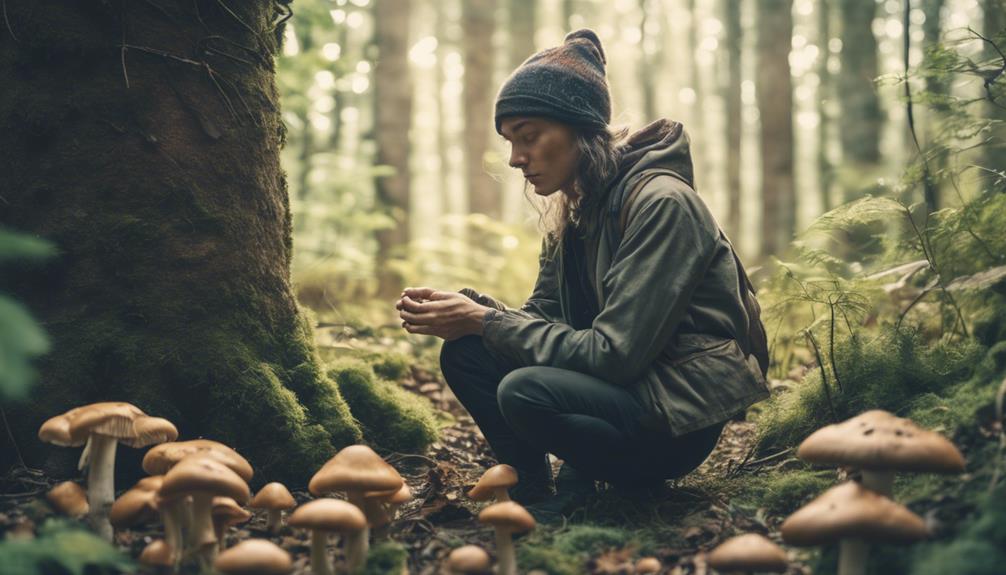
By delving into the history of foraging, you'll uncover a rich tapestry of ancient food systems that have been woven into the fabric of cultures worldwide. You'll discover that foraging, an ancient practice, is still alive today, involving the gathering of wild plants, fruits, and fungi for sustenance.
As you explore the world of foraging, you'll find that modern foragers can access extensive catalogs of edibles through handy apps and online resources. However, conducting research before consuming any foraged items is crucial to guarantee safety and proper identification.
You'll learn that foraging traditions have evolved with the help of contemporary botanists and mycologists. By rediscovering ancient food systems, you'll gain a deeper understanding of the connection between nature and the food on your plate.
Foraging offers a unique opportunity to connect with nature and discover edible plants, fungi, and insects in your local environment.
Health Benefits of Wild Edibles

You'll discover that the wild edibles you forage offer a wealth of health benefits, from boosting your immune system to providing a rich source of vitamins, minerals, and antioxidants. By incorporating wild edibles into your diet, you'll not only enjoy fresh, organic alternatives to store-bought produce but also support sustainable, local food systems and reduce your reliance on processed foods.
Here are some examples of wild edibles and their health benefits:
| Wild Edible | Health Benefits |
|---|---|
| Dandelion Greens | Rich in vitamins A, C, and K, and minerals like potassium and iron |
| Wild Berries | High in antioxidants, vitamins C and K, and fiber |
| Chicory | Supports digestive health and contains inulin, a prebiotic fiber |
| Burdock Root | Rich in vitamins B6 and C, and minerals like potassium and manganese |
| Wild Garlic | Has antibacterial and antiviral properties, and supports heart health |
Preserving Cultural Heritage Practices
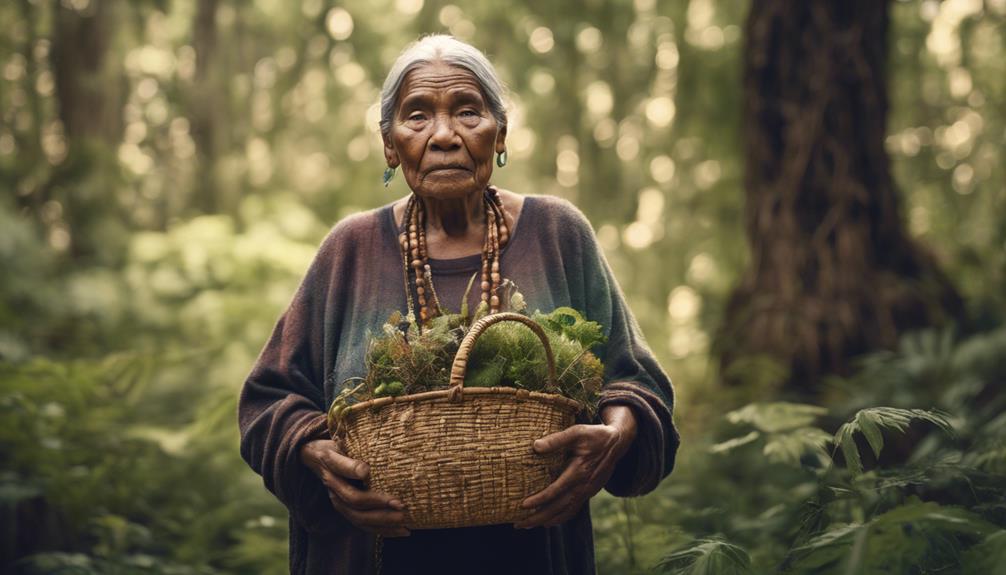
As you explore the significance of preserving cultural heritage practices in foraging, you'll discover the importance of traditional techniques, evolving preservation methods, and community knowledge sharing.
These essential elements guarantee the continuation of indigenous foraging practices, allowing future generations to benefit from the valuable insights and ecological knowledge of traditional foragers.
Traditional Foraging Techniques
Traditional foraging techniques, passed down through generations, serve as an indispensable link to cultural heritage practices that have sustained indigenous communities for centuries. You're likely aware that these techniques have been refined over time, ensuring the long-term availability of wild plants and resources.
Indigenous communities hold deep knowledge of traditional foraging methods, which involve sustainable harvesting practices to maintain ecological balance. Foraging traditions are integral to cultural identity and spiritual beliefs, reflecting a deep connection to the natural world. By preserving traditional foraging techniques, you're contributing to the maintenance of biodiversity, ecological balance, and cultural diversity.
These practices are more than just a means of gathering food; they're a crucial part of cultural heritage. As you explore modern-day foraging practices, it's imperative to recognize the significance of traditional techniques in sustaining ecosystems and communities. By embracing these time-tested methods, you'll not only be preserving cultural heritage but also ensuring a sustainable future for generations to come.
Preservation Methods Evolve
By building upon the foundation of traditional foraging techniques, modern foragers have adapted ancestral preservation methods to secure the longevity of wild edibles, merging time-honored practices with innovative technologies.
You're probably wondering how they do it. Well, modern foragers have updated traditional preservation methods like drying, smoking, and fermenting to safeguard foraged foods. They've also incorporated new techniques like canning, freezing, and vacuum sealing to extend the shelf life of their foraged goods.
By combining ancestral practices with modern technology, foragers can guarantee the longevity of their foraged foods without compromising their nutritional value or quality. This integration of sustainable and eco-friendly preservation methods not only maintains cultural heritage practices but also enhances food safety and accessibility.
As you explore modern foraging practices, you'll discover how these evolved preservation methods play a crucial role in making wild edibles a sustainable and reliable food source.
Community Knowledge Sharing
Through community knowledge sharing, you're not only preserving cultural heritage practices but also tapping into the collective wisdom of indigenous communities who've spent generations refining their foraging techniques.
By sharing their Traditional Ecological Knowledge, indigenous communities can pass on essential ecological knowledge and cultural diversity to future generations. This knowledge is rooted in their deep understanding of the natural environment and plant uses, which has been integral to their cultural traditions and spiritual practices for generations.
Community knowledge sharing fosters cultural heritage preservation and ecological stewardship. By sharing their expertise, traditional foragers can empower others to adopt sustainable foraging practices, promoting a deeper respect for the natural world.
This collective knowledge can also inform conservation efforts, ensuring the long-term preservation of ecosystems. By embracing community knowledge sharing, you're not only learning from indigenous communities but also contributing to the preservation of cultural heritage practices.
Ecological Advantages of Foraging

As you explore the ecological advantages of foraging, you'll discover the significant impact it has on the environment.
By foraging, you're contributing to biodiversity conservation efforts, enhancing soil health, and boosting ecosystem resilience.
These benefits not only support the health of local ecosystems but also promote a more sustainable relationship between humans and nature.
Biodiversity Conservation Efforts
Frequently, foraging practices prioritize biodiversity conservation by promoting the coexistence of diverse species and reducing the spread of invasive plants. As you venture into the world of foraging, you'll find that sustainable practices contribute to maintaining ecological balance and preserving natural habitats. By focusing on abundant resources and avoiding rare or scarce items, foragers minimize their ecological impact.
| Conservation Efforts | Ecological Benefits | Practical Tips |
|---|---|---|
| Promoting local species | Preserves natural habitats | Identify invasive species to avoid |
| Combating invasive plants | Maintains ecological balance | Focus on abundant resources |
| Ecological stewardship | Supports biodiversity | Join organizations for guidance |
The Association of Foragers promotes ecological stewardship and responsible foraging practices for conservation efforts. By adopting sustainable foraging practices, you'll not only contribute to biodiversity conservation but also generate socioeconomic and cultural value in metropolitan areas.
Soil Health Enhancement
By adopting sustainable foraging practices, you're not only contributing to biodiversity conservation, but you're also enhancing soil health through natural nutrient cycling and promoting healthy soil ecosystems.
As you forage for wild plants and fungi, you're helping to improve soil structure and fertility. This, in turn, reduces the need for chemical inputs, which can harm soil health.
By preserving natural habitats, foraging practices support the maintenance of healthy soil ecosystems. You're playing an essential role in promoting sustainable land management practices through your activities.
As a forager, you're part of a larger effort to conserve soil health, and every small action counts. By choosing sustainable foraging practices, you're contributing to the preservation of natural habitats and promoting healthy soil ecosystems.
This, in turn, has a ripple effect, supporting the overall health of our environment.
Ecosystem Resilience Boost
Through your deliberate foraging practices, you're fortifying ecosystem resilience by preserving natural habitats and promoting ecological balance. By adopting sustainable foraging practices, you're supporting biodiversity, combating invasive species, and contributing to conservation efforts. This, in turn, enhances ecosystem resilience, allowing natural habitats to thrive.
Your responsible foraging practices also maintain local species, promote ecological balance, and preserve natural habitats. By doing so, you're fostering a deeper connection with nature and supporting local economies and communities. Additionally, foraging provides an opportunity to address environmental challenges, promote ecosystem health, and strengthen ecological stewardship.
Building Sustainable Communities

As you explore the concept of building sustainable communities, you'll find that foraging plays an essential role in fostering a sense of unity and environmental responsibility. By promoting local food sources, foraging reduces reliance on industrialized agriculture, supporting biodiversity and ecological balance within communities. This, in turn, strengthens community bonds through shared knowledge, solidarity initiatives, and mutual support.
Moreover, foraging networks can supplement local economies, improve mental health, and promote inclusivity within communities. By foraging responsibly, individuals can actively participate in environmental stewardship and support ecosystem health within their communities. This collective effort contributes to building sustainable communities, where residents work together to maintain ecological balance and promote environmental well-being.
Foraging as a Food Revolution
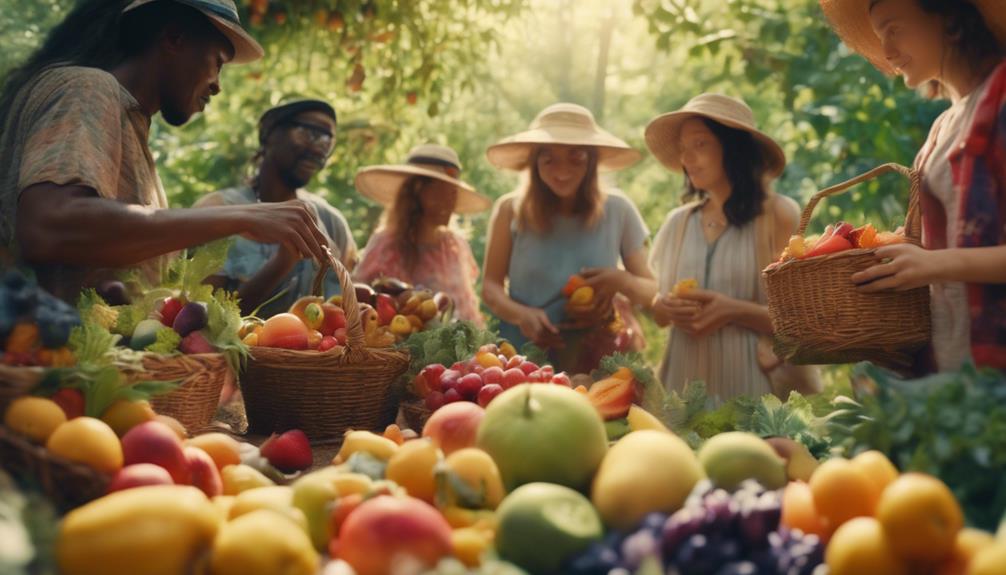
You're likely part of a growing movement if you're curious about foraging, a practice that's re-emerging as a revolutionary food trend. As a modern-day forager, you're part of a community that's rediscovering the benefits of wild edible plants.
Foraging is no longer just about sustenance; it's a movement that promotes sustainable living, biodiversity conservation, and a deeper connection with nature.
Here are three key aspects of modern-day foraging:
- Sustainable practices: Many foragers today focus on promoting biodiversity conservation and reducing reliance on grocery store produce.
- Education and community: Foraging clubs, experts, and community initiatives play a key role in educating and supporting individuals interested in modern-day foraging practices.
- Technology integration: Online resources and apps have made it easier for modern foragers to identify, harvest, and prepare wild plants and fungi.
As you commence on this food revolution, remember to always exercise caution and respect for the environment. Research, avoid contaminated areas, and respect ethical guidelines while foraging.
Modern Foraging Techniques and Tools
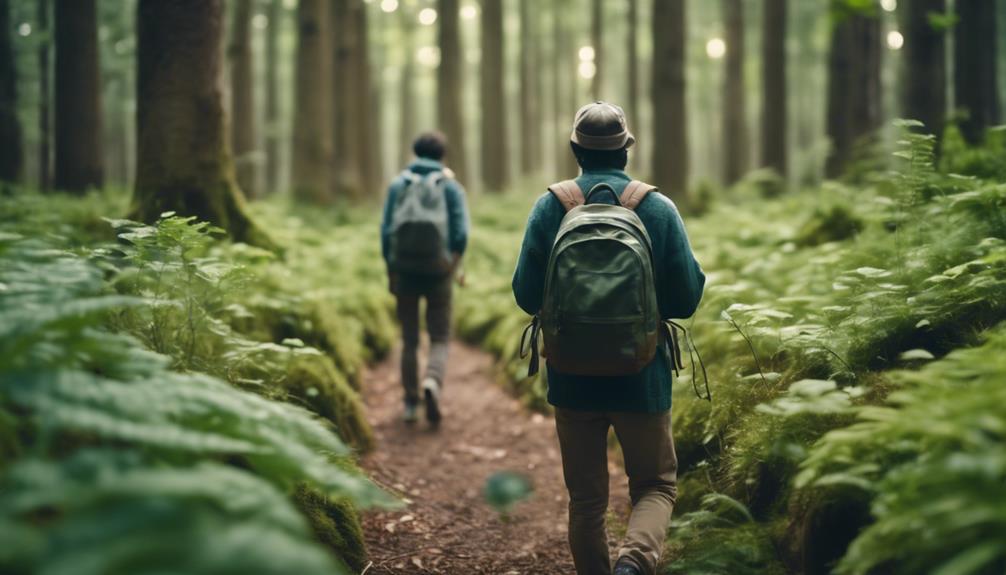
Embracing modern foraging techniques and tools enables you to tap into a vast network of resources, from online plant directories to expert guidance, and harness the power of technology to elevate your foraging experience. You can explore extensive plant directories like Plants for a Future, which provides detailed information on edible wild plants. Additionally, mapping tools like Fallingfruit.org help you locate foraging hotspots in your area.
| Modern Foraging Tools | Description |
|---|---|
| Foragers Buddy | Identify and document wild edibles in your area |
| iNaturalist | Learn about and record observations of edible plants and fungi |
| Plants for a Future | Access a vast directory of edible wild plants |
| Fallingfruit.org | Map foraging hotspots and find nearby foraging locations |
The Future of Wild Food Systems

By integrating traditional foraging wisdom with modern knowledge, you'll be contributing to the development of sustainable wild food systems that balance biodiversity conservation with responsible harvesting practices.
As a modern forager, you're part of a growing movement that's shaping the future of wild food systems. To guarantee a thriving food system, it's crucial to combine traditional practices with contemporary knowledge.
Here are three key takeaways to keep in mind:
- Responsible foraging practices: Avoid contaminated areas, respect local regulations, and prioritize biodiversity conservation.
- Collaboration with foraging groups: Join online forums, attend workshops, and connect with local foraging communities to share knowledge and best practices.
- Continuous learning and adaptation: Stay updated on the latest research, adapt to changing environmental conditions, and refine your foraging skills to secure a sustainable food system.
Frequently Asked Questions
Does Foraging Still Exist?
You wonder if foraging still exists, and the answer is yes! Modern-day foragers leverage technology, expert guidance, and careful research to safely discover edible treasures in their local environments, reconnecting with nature and their communities.
Is Foraging Illegal in the Us?
As you ponder foraging's legality, coincidentally, you're standing in a state where laws vary – it's not entirely illegal, but you must navigate local regulations, respecting protected areas and private property to avoid fines or trespassing charges.
Are True or False Foraging Societies Exist in the 21ST Century?
You won't find many true foraging societies where people solely rely on hunting and gathering for food, but some indigenous communities still practice traditional foraging methods alongside other food production techniques in the 21st century.
Why Is Foraging Becoming Popular?
You're drawn to foraging because you crave a deeper connection with nature and a healthier lifestyle. As you seek sustainable food options, you're driven by a desire to reduce your reliance on store-bought produce and discover wild, nutritious foods.
Conclusion
As you commence on your foraging journey, remember that the wild edibles at your fingertips hold the power to revitalize your health, preserve cultural heritage, and foster sustainable communities.
Like a thread weaving together the fabric of our collective past, present, and future, foraging stitches together the tapestry of our relationship with nature.
By embracing this ancient practice, you're not just gathering food – you're cultivating a deeper connection with the earth and its rhythms.
Foraging Guides
Does Forage Take Reservations? Get the Inside Scoop!
Just wondering if you can snag a table at Forage? Discover the surprising answer to this question and more!

You don't need to plan ahead or stress about securing a table at Forage, as this popular eatery operates on a first-come, first-served basis, eliminating the need for reservations altogether. Forage doesn't accept reservations, so arrive early for seating, especially during peak hours. If there's a wait, you can put your name on the waitlist, providing your name, party size, and contact info, and receive a text notification when your table is ready. Want to minimize your wait time? Try visiting during off-peak hours or planning strategically to avoid peak hours. There's more to explore about Forage's seating policy – keep going to learn more about planning your visit.
Key Takeaways
- Forage Kitchen does not take reservations, operating on a first-come, first-served basis.
- Arrive early to secure a table, as seating is limited with a restricted number of tables.
- A waitlist is available, requiring name, party size, and contact information to join and receive a text notification when a table is ready.
- Visit during off-peak hours, before or after traditional dining hours, to minimize wait time and enjoy a more relaxed dining experience.
- Check the current seating situation before heading to Forage to plan your visit strategically.
Forage Reservation Policy Explained
When planning your visit to Forage Kitchen, it's important to understand that this farm-to-table eatery operates on a unique reservation policy. Unlike other restaurants, Forage Kitchen doesn't take reservations, embracing a first-come, first-served approach instead. This means you can simply walk in during operating hours and grab a seat based on availability.
No need to plan weeks in advance or stress about securing a table – just show up and enjoy! This laid-back approach allows for a more spontaneous and relaxed dining experience. And, let's be honest, who doesn't love the thrill of scoring a table on a whim?
Plus, it's the perfect excuse to indulge in a sweet treat while you wait – maybe even a scoop (or two) of your favorite ice cream. So, get the inside scoop on Forage Kitchen's reservation policy and enjoy the freedom to dine on your own terms.
Making a Reservation at Forage

Since you're planning to visit Forage Kitchen, you might be wondering how to make a reservation, but the truth is, you don't need to – the restaurant operates on a walk-in basis. This means you can simply show up and grab a seat at the communal tables whenever you're ready to dine.
| Benefit | Description | What it means for you |
|---|---|---|
| Flexibility | No need to book ahead | You can dine on your own schedule |
| Social Dining | Communal seating encourages socializing | Meet new people and make friends |
| Easy Seating | Open seating policy means no waiting | Grab a seat and start dining |
| Casual Atmosphere | Welcoming vibe makes it easy to find a spot | Relax and enjoy your meal |
How to Book a Table

Planning your visit accordingly is vital, as Forage Kitchen doesn't accept reservations, so you can't book a table in advance. You'll need to arrive early to secure a spot, especially during peak dining hours. Since seating is limited, it's important to plan ahead to avoid waiting.
If you're planning a larger gathering or special event, Forage Kitchen might've options for private bookings or buyouts. For more information, it's best to contact them directly to inquire about these arrangements.
Keep in mind that Forage Kitchen operates on a first-come, first-served basis, so it's crucial to plan your visit strategically. By arriving early and being flexible, you can increase your chances of getting a table. Remember, it's always better to plan ahead to avoid disappointment.
Forage Table Availability

You'll need to arrive early to secure a table at Forage Kitchen, as its limited seating and no-reservation policy can lead to waits during peak dining hours. This setup creates a lively atmosphere, where you can mingle with fellow foodies while waiting for a table.
However, it's important to plan ahead and be prepared for a wait, especially during busy times.
Here are some key takeaways to keep in mind:
- Limited seating: Forage Kitchen has a restricted number of tables, making early arrival important.
- No reservations: The restaurant operates on a first-come, first-served basis, so be prepared to wait.
- Peak hours: Expect longer waits during popular dining times, like lunch and dinner rushes.
- Casual atmosphere: The no-reservation policy contributes to a relaxed, communal vibe.
Planning Ahead With Forage

When planning ahead with Forage, you'll want to contemplate booking in advance, even though they don't take reservations.
By doing so, you'll make the most of your meal planning and avoid waiting in line during peak hours.
Booking in Advance
When you're looking to dine at Forage Kitchen, you can simply show up and grab a seat, as they don't require reservations for their communal dining space. This means you can plan your meal on the fly, without needing to book ahead of time. The first-come, first-served policy allows for a more spontaneous dining experience.
Here are a few benefits of Forage Kitchen's open seating concept:
- Flexibility: You can show up whenever you're hungry, without worrying about a specific reservation time.
- Casual atmosphere: The welcoming and inclusive vibe at Forage Kitchen makes it perfect for a low-key meal.
- Spontaneity: You can grab a seat whenever you want, without needing to plan ahead.
- Relaxed dining: The open seating concept takes the pressure off, allowing you to focus on enjoying your meal.
Meal Planning Made
By planning ahead, you can minimize your wait time and make the most of your dining experience at Forage Kitchen. Since Forage operates on a first-come, first-served basis, it's crucial to plan your visit strategically.
Consider arriving before or after traditional dining hours for a better chance of getting seated quickly. If you can, aim to visit during off-peak hours when the restaurant is less busy. This will give you a more relaxed dining experience and reduce your wait time considerably.
By doing so, you'll be able to enjoy your meal without feeling rushed or stressed about getting a table. Additionally, planning ahead allows you to make the most of your visit, taking in the atmosphere and savoring your food without feeling anxious about long waits.
Avoiding Wait Times
To minimize wait times at Forage Kitchen, you'll need to plan strategically, taking into account peak hours and off-peak windows when the restaurant is less crowded. Since Forage Kitchen doesn't take reservations, it's important to arrive at the right time to secure a table quickly.
Here are some tips to help you avoid long wait times:
- Arrive early: Beat the crowds by showing up before the lunch or dinner rush.
- Avoid peak hours: Steer clear of times when Forage Kitchen is busiest, usually between 12 pm and 2 pm for lunch, and 6 pm to 8 pm for dinner.
- Take advantage of off-peak times: Visit during slower periods, like between 2 pm and 5 pm, when the restaurant is less crowded.
- Have a backup plan: Be prepared for unexpected wait times by having an alternative plan, like grabbing a drink at the bar or taking a short walk around the area.
Is Forage Reservation Required

You don't need a reservation to dine at Forage in Oakland, as they operate on a first-come, first-served basis. This means you can simply walk in and be seated as soon as a table becomes available. The restaurant encourages guests to do so, promoting a more spontaneous dining experience. Keep in mind that waiting times may vary depending on the day and time of your visit.
If you're planning to dine during peak hours, it's a good idea to plan ahead and expect a possible wait. However, Forage is generally able to accommodate both small and large groups, so you don't need to worry about arranging a reservation for your party. By showing up when you're ready, you can enjoy a more flexible and relaxed dining experience at Forage.
Forage Seating and Capacity

As you step into Forage, you'll notice the cozy atmosphere is tempered by the limited seating capacity, which can lead to wait times during peak hours. The restaurant's layout contributes to this limited capacity, making it important to plan your visit accordingly.
Here are a few things to keep in mind when it comes to Forage's seating and capacity:
- Cozy but cramped: Forage's intimate setting means there's limited space for diners, making it important to arrive early to secure a table.
- Peak hour wait times: Be prepared to wait during weekends or special occasions, as the restaurant can get quite busy.
- First-come, first-served: Since Forage doesn't take reservations, it's crucial to arrive early to secure a comfortable dining experience.
- Walk-in friendly: While Forage prioritizes walk-in guests, it's important to be prepared to wait for a table, especially during peak hours.
Reserving a Spot at Forage

When you arrive at Forage, you'll want to know what to expect. To secure a table, you'll need to plan ahead and arrive early, especially during peak hours.
Let's explore the details of table availability, the booking process, and waitlist options to make the most of your Forage experience.
Table Availability Check
Given that Forage operates on a first-come, first-served basis, it's important to check the current table availability before heading to the restaurant. You wouldn't want to arrive only to find out there's a wait, right?
To avoid any inconvenience, it's vital to plan ahead and check the current seating situation.
Here's what you can do to get an idea of the table availability:
- Call ahead: Give Forage a quick call to ask about the current wait time or availability.
- Check social media: Follow Forage on social media platforms to get updates on their current crowd situation.
- Visit in person: If you're in the area, you can always stop by to ask about availability.
- Plan your visit strategically: If you can, try to avoid peak dining hours to minimize your wait time.
Booking Process Details
Planning ahead is vital at Forage Kitchen, where the motto is 'first-come, first-served,' so make sure to prepare in advance to snag a table. Since Forage doesn't take reservations, you'll want to arrive early to guarantee seating availability. This approach adds to the casual, communal vibe of the kitchen, allowing for flexibility and spontaneity in your dining arrangements.
You can simply show up, grab a seat, and enjoy the lively atmosphere and diverse menu options without the hassle of reservations. By ditching reservations, Forage fosters a carefree, come-as-you-are environment that's perfect for spontaneous gatherings or casual meetups. So, don't stress about booking a table; just arrive early, and you'll be all set.
With Forage's open seating policy, you can focus on what really matters – savoring the food and company. With this laid-back approach, you'll be free to indulge in the culinary delights and soak up the energetic atmosphere that Forage Kitchen has to offer.
Waitlist Options Explained
You can reserve a spot at Forage Kitchen by joining their waitlist, which allows you to secure a table without physically waiting in line. This convenient system guarantees that you can enjoy your meal without the hassle of waiting.
Here's how it works:
- Provide your details: Give Forage your name, party size, and contact information to join the waitlist.
- Get notified: When your table is ready, you'll receive a text message to let you know.
- Skip the line: With the waitlist, you can bypass the physical line and go straight to your table.
- Enjoy your meal: With minimal wait times, you can focus on enjoying your meal at Forage Kitchen.
Forage Walk-In Policy

Freedom to dine on a whim is yours at Forage, where a walk-in policy guarantees spontaneity prevails. You can simply show up, no reservation required, and enjoy their farm-to-table menu.
Forage operates on a first-come, first-served basis, accommodating guests based on availability. This walk-in policy allows for a more spontaneous dining experience, perfect for those who like to live in the moment.
Keep in mind that you may need to plan ahead or be prepared to wait during peak dining hours. If you're looking to avoid a wait, consider arriving early.
Forage's walk-in policy is designed to be flexible and convenient, so you can make the most of your dining experience. By not taking reservations, Forage encourages a more relaxed and casual atmosphere, where you can drop by whenever you're in the mood for a delicious meal.
Frequently Asked Questions
Does Forage Offer Special Occasion or Birthday Reservations?
You're wondering if Forage offers special occasion or birthday reservations? Yes, you can book a private dining room for celebrations, and they'll even help you plan a customized menu to make it a memorable event!
Can I Reserve a Specific Table or Area at Forage?
"Cut to the chase, you're wondering if you can reserve a specific table or area at Forage. Unfortunately, they don't offer table selection, but you can request a spot near the window or patio, and they'll do their best to accommodate you."
Are There Any Discounts for Large Group Reservations at Forage?
You're wondering if Forage offers discounts for large group reservations. The answer is yes, they do! You'll get a special rate for parties of 10 or more, making your gathering even more affordable and fun.
Can I Change or Cancel My Forage Reservation Online?
You can easily modify or cancel your Forage reservation online through their website or mobile app, but be aware that some changes or cancellations may incur fees or penalties, so review their policy beforehand.
Does Forage Offer Private Dining Rooms for Events?
You're planning an event and wondering if Forage has private dining rooms. Yes, you can book their private rooms for events, accommodating up to 40 guests for a sit-down dinner or 60 for a cocktail party.
Conclusion
Now that you've got the inside scoop on Forage's reservation policy, you can plan your visit with confidence. Make a reservation to secure a table, but don't worry if you forget – walk-ins are welcome too.
With a clear understanding of their seating capacity and table availability, you can plan ahead and make the most of your dining experience. Remember to book in advance for popular times, and you'll be all set for a great meal at Forage!
-
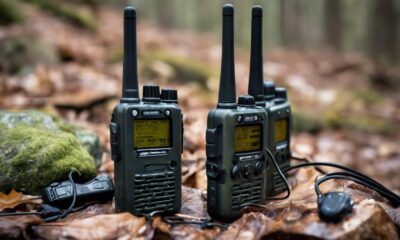
 Coastal Foraging2 weeks ago
Coastal Foraging2 weeks ago15 Best GMRS Radios for Preppers: Stay Prepared and Connected in Any Situation
-

 Coastal Foraging2 weeks ago
Coastal Foraging2 weeks ago15 Best Foods for Preppers to Stock Up on Now
-

 Survivalism2 weeks ago
Survivalism2 weeks agoPreppers Netflix: Top Shows to Watch for Survival Tips!
-

 How to Forage3 weeks ago
How to Forage3 weeks agoUnlock Nature’s Bounty: How to Forage in Alaska Like a Pro!
-

 Spearfishing2 weeks ago
Spearfishing2 weeks agoTraveling with Spear Gear 101: Essential why Tips
-

 How to Forage2 weeks ago
How to Forage2 weeks agoMinnesota Foraging Fun: Discover Wild Edibles Everywhere!
-

 Foraging Guides1 week ago
Foraging Guides1 week agoCan You Eat Forage Turnips? Uncover the Edible Secrets!
-

 Foraging Guides2 weeks ago
Foraging Guides2 weeks agoJune Foraging Secrets: Find the Best Wild Foods of Early Summer!















